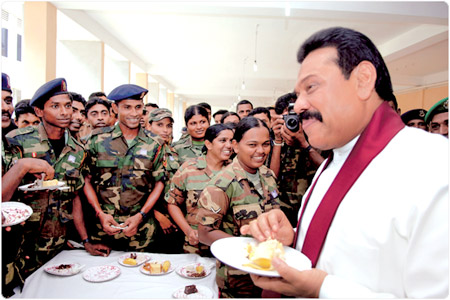A unified Sri Lanka on the path to rapid progress
By Uditha Kumarasinghe
President Mahinda Rajapaksa is the only
national leader who openly challenged the unwinnable war theory of the
West and proved to the entire world that terrorism could be defeated
through military means. The President by his strategy defeated the LTTE,
the most ruthless terrorist outfit in the world by setting an example to
the terror-stricken world.
|

President Mahinda Rajapaksa with Forces personnel |
This landmark victory achieved by Sri Lanka made the West think twice
before intervening in the internal conflicts of other countries. Today
the West is not in a position to advise any conflict-ridden country to
adopt their theories any more. Therefore, Sri Lanka's defeat of
terrorism is a wake up call to other countries fighting terrorism on a
global scale.
President Rajapaksa's name is etched in history as the only leader
who gave political leadership to defeat the world's most ruthless
terrorist organisation and unite the country. He has embarked on an
ambitious program to ensure democracy throughout the country, bringing a
new political vision of development and reconciliation for a unified Sri
Lankan nation.
Earlier, the Western countries had their own strategies of resolving
internal problems and conflicts. They held the belief that an internal
issue in a country cannot be settled through military means. Each
university in the West while profounding this theory has introduced new
subjects such as conflict resolution, conflict management and conflict
transformation. The essence of this theory was that an internal problem
of any country could be settled through negotiations and not by military
means. In fact, they did not call those who had resorted to terrorist
activities as terrorists but rebels. The Western countries did not use
the word "terrorism" but they preferred 'conflict' or 'crisis'.
In this connection Sri Lanka is a case in point. Even the former
leaders who ruled this country had acquiesced in. It is evident that all
those countries which blindly followed this were finally divided.
Terrorist problem
However, President Rajapaksa, the first world leader who openly
challenged this Western assertion categorically said that the terrorist
problem in Sri Lanka could be solved only through military means. This
is the unique feature of President Rajapaksa's political sagacity
compared to other world leaders.
The Sri Lankan Security Forces' recapture of Mavilaru was the
springboard to launch a major humanitarian operation to free the entire
Northern Province from the grip of the LTTE. With the professionalism of
the Security Forces being promoted under the President's political
stewardship terrorism could be eradicated from the Sri Lankan soil on
May 19, 2009.
Sri Lanka remained a technically divided country when President
Rajapaksa took the reins of this country. Even those superpowers such as
the US and UK concede that we were dealing with the most powerful
terrorist organisation in the world. They pressurised the President not
even to think of waging a war with the LTTE but to go for negotiations.
The President did not hesitate to take a determined stand on behalf of
the country. In consultation with Defence Secretary Gotabaya Rajapaksa
and the Security Forces, he made up his mind to launch a military
campaign to liberate the country.
Despite mounting international pressure, the military operations were
launched against terrorists in the form of a humanitarian operation. The
President never bowed down to international pressure. The country is
fortunate to have a dynamic leader such as President Rajapaksa.
Second term
President Rajapaksa was elected for a second term of office at the
Presidential election on January 26, 2010. The vast majority of the
people recognised him as the true national leader who liberated the
country from the clutches of LTTE terrorism and led it on the path of
peace and rapid economic development.
He had set a record in Sri Lankan political history being the first
Executive President who led his party to a resounding victory in
parliamentary elections held just over two months after his being
elected for his second term of office. The President's farsighted vision
and leadership have helped the UPFA to secure a two-third majority in
Parliament. After the defeat of terrorism, a massive transformation has
taken place in the entire country. The Sri Lankan economy has shown
remarkable resilience to register a healthy increase in its GDP. It is
acknowledged that the recent high growth has pushed Sri Lanka to the
level of a lower middle income country. Therefore, the peace dividend
has enabled Sri Lanka to become one of the fastest growing economies in
the region. At present the entire country especially those in the North
and the East are enjoying the dividends of peace. The country's per
capita income has also shown a significant increase. All economic
indicators too have shown a positive outlook.
The establishment of the Southern Expressway, Magampura Mahinda
Rajapaksa Port and Mattala Rajapaksa International Airport bear
testimony to the rapid development in the country after defeating
terrorism. The government is committed to channel the equal
socio-economic and development benefits to the North and the East.
The Government has introduced the Divineguma program to uplift the
socio-economic standards of low-income groups. This has helped bring
down the strength of the poorest of the poor to less than nine percent
from around 15 to 20 percent in the past. Other sectors such as business
and tourism are also moving ahead fast. The Government has laid the
infrastructure to make Sri Lanka one of the key tourist destinations in
the world. As a result, tourist arrivals have shown a dramatic
improvement in recent times. |


